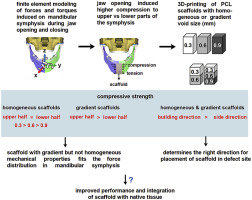Journal of the Mechanical Behavior of Biomedical Materials ( IF 3.3 ) Pub Date : 2020-01-14 , DOI: 10.1016/j.jmbbm.2020.103638 Yasaman Zamani 1 , Ghassem Amoabediny 2 , Javad Mohammadi 3 , Hadi Seddiqi 4 , Marco N Helder 5 , Behrouz Zandieh-Doulabi 6 , Jenneke Klein-Nulend 6 , Jan Harm Koolstra 7

|
In bone tissue engineering, prediction of forces induced to the native bone during normal functioning is important in the design, fabrication, and integration of a scaffold with the host. The aim of this study was to customize the mechanical properties of a layer-by-layer 3D-printed poly(ϵ-caprolactone) (PCL) scaffold estimated by finite element (FE) modeling in order to match the requirements of the defect, to prevent mechanical failure, and ensure optimal integration with the surrounding tissue. Forces and torques induced on the mandibular symphysis during jaw opening and closing were predicted by FE modeling. Based on the predicted forces, homogeneous-structured PCL scaffolds with 3 different void sizes (0.3, 0.6, and 0.9 mm) were designed and 3D-printed using an extrusion based 3D-bioprinter. In addition, 2 gradient-structured scaffolds were designed and 3D-printed. The first gradient scaffold contained 2 regions (0.3 mm and 0.6 mm void size in the upper and lower half, respectively), whereas the second gradient scaffold contained 3 regions (void sizes of 0.3, 0.6, and 0.9 mm in the upper, middle and lower third, respectively). Scaffolds were tested for their compressive and tensile strength in the upper and lower halves. The actual void size of the homogeneous scaffolds with designed void size of 0.3, 0.6, and 0.9 mm was 0.20, 0.59, and 0.95 mm, respectively. FE modeling showed that during opening and closing of the jaw, the highest force induced on the symphysis was a compressive force in the transverse direction. The compressive force was induced throughout the symphyseal line and reduced from top (362.5 N, compressive force) to bottom (107.5 N, tensile force) of the symphysis. Compressive and tensile strength of homogeneous scaffolds decreased by 1.4-fold to 3-fold with increasing scaffold void size. Both gradient scaffolds had higher compressive strength in the upper half (2 region-gradient scaffold: 4.9 MPa; 3 region-gradient scaffold: 4.1 MPa) compared with the lower half (2 region-gradient scaffold: 2.5 MPa; 3 region-gradient scaffold: 2.7 MPa) of the scaffold. 3D-printed PCL scaffolds had higher compressive strength in the scaffold layer-by-layer building direction compared with the side direction, and a very low tensile strength in the scaffold layer-by-layer building direction. Fluid shear stress and fluid pressure distribution in the gradient scaffolds were more homogeneous than in the 0.3 mm void size scaffold and similar to the 0.6 mm and 0.9 mm void size scaffolds. In conclusion, these data show that the mechanical properties of 3D-printed PCL scaffolds can be tailored based on the predicted forces on the mandibular symphysis. These 3D-printed PCL scaffolds had different mechanical properties in scaffold building direction compared with the side direction, which should be taken into account when placing the scaffold in the defect site. Our findings might have implications for improved performance and integration of scaffolds with native tissue.
中文翻译:

3D打印的聚(ε-己内酯)支架,根据下颌骨组织工程中下颌骨中的力分布具有渐变的机械性能。
在骨组织工程中,预测在正常功能过程中诱导到天然骨的力在支架,主体与支架的设计,制造和集成中很重要。这项研究的目的是定制通过有限元(FE)建模估算的逐层3D打印的聚(ε-己内酯)(PCL)支架的机械性能,以符合缺陷的要求,防止机械故障,并确保与周围组织的最佳融合。通过有限元建模预测下颌张开和闭合期间在下颌骨上产生的力和扭矩。根据预测的力,设计了具有3种不同的空隙尺寸(0.3、0.6和0.9毫米)的均质结构PCL支架,并使用基于挤出的3D生物打印机对3D打印。此外,设计了2个梯度结构的支架并进行了3D打印。第一个梯度支架包含2个区域(上半部分和下半部分分别为0.3 mm和0.6 mm的空隙尺寸),而第二个梯度支架包含3个区域(上,中和下部分别为0.3、0.6和0.9 mm的空隙尺寸)分别降低三分之一)。测试了支架在上半部分和下半部分的抗压强度和拉伸强度。设计空隙尺寸为0.3、0.6和0.9 mm的均质支架的实际空隙尺寸分别为0.20、0.59和0.95 mm。有限元建模表明,在颌骨张开和闭合期间,在共骨上引起的最大力是横向方向上的压缩力。整个共骨线上都产生了压缩力,并从顶部(362.5 N,压缩力)降低到底部(107.5 N,拉伸力)随着支架空隙尺寸的增加,均质支架的抗压强度和拉伸强度降低了1.4倍至3倍。与下半部分(2个区域梯度支架:2.5 MPa; 3个区域梯度支架)相比,两个梯度支架的上半部分(2个区域梯度支架:4.9 MPa; 3个区域梯度支架:4.1 MPa)均具有较高的抗压强度。 :2.7MPa)的支架。与侧面方向相比,3D打印的PCL支架在支架的逐层构建方向上具有更高的抗压强度,并且在支架的逐层构建方向上具有非常低的拉伸强度。梯度支架中的流体剪切应力和流体压力分布比0.3 mm空隙尺寸的支架更均匀,并且与0.6 mm和0.9 mm空隙尺寸的支架相似。总之,这些数据表明,可以基于对下颌骨的预测力来定制3D打印的PCL支架的机械性能。与侧面方向相比,这些3D打印的PCL支架在支架构建方向上具有不同的机械性能,在将支架放置在缺陷部位时应予以考虑。我们的发现可能对改善性能以及将支架与天然组织整合具有影响。









































 京公网安备 11010802027423号
京公网安备 11010802027423号